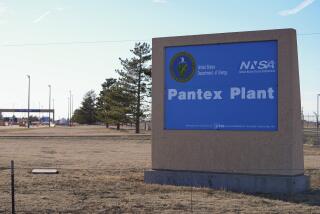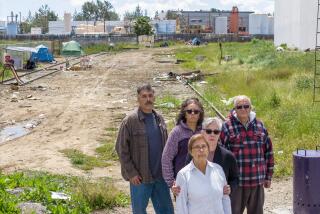Critics Ask Rockwell to Disclose Plan for âHot Labâ : Offer Specifics or Drop License Request, They Say
A national environmental group Friday called on Rockwell International to clarify its plans for use of the heavily shielded âhot labâ at the Santa Susana Field Laboratory west of Chatsworth or abandon its request for renewal of a nuclear materials license.
Rockwell has asked the U. S. Nuclear Regulatory Commission for a 10-year extension of its license to operate the hot lab, where the firm has dismantled nuclear fuel rods under contracts with the U. S. Department of Energy.
But in testimony at a commission hearing in Van Nuys on Rockwellâs extension request, representatives of the Natural Resources Defense Council said the only big project now planned for the hot lab is cleanup from prior work.
Wants Specifics
âWe would like Rockwell to make clear their intentions for using the hot lab,â said James Werner, a project engineer with the Washington-based council. If Rockwell does not have specific plans to use the hot lab, the company should withdraw its bid to extend the license, Werner said.
Pat Coulter, a spokesman for Rockwellâs Rocketdyne Division, said the firm cannot seek new business for the hot lab at its Santa Susana complex in the Simi Hills southeast of Simi Valley without a license to run it. âHaving the license allows us to take a look at those opportunities as they present themselves,â Coulter said.
Following Fridayâs hearing--the second in two days on Rockwellâs relicensing request--the administrative judge presiding in the case granted the requests of three local residents to intervene in the case. Judge Peter B. Bloch granted intervenor status to Jerome Raskin and Estelle Lit of Northridge and Jon Scott of Bell Canyon, allowing them to file written evidence against Rockwellâs application.
Some Rulings Deferred
Bloch deferred a ruling on requests by the council and several individuals who asked to intervene too late for Rockwell to comment on the requests. The councilâs request was made jointly with Physicians for Social Responsibility, another anti-nuclear group. Bloch said he must hear Rockwellâs response before deciding whether to allow more intervenors.
It is likely to be a year or more before Bloch decides whether to grant the license request, according to schedules outlined Friday by NRC officials. The hot lab license, which technically expired in June, will remain in effect pending the decision.
Based on deadlines set by Bloch for filing evidence and rebuttal documents, the case will not be decided until the summer of 1990. NRC staff reports on hot lab safety and environmental effects are also not due until then, NRC spokesman Greg Cook said.
Although the NRC license would allow Rockwell to sign up commercial clients, the hot labâs main customer has been the Department of Energyâs defense programs branch.
Handled Fuel Rods
Until 1986, DOE utilized the highly specialized lab to âdeclad,â or dismantle, nuclear fuel rods. That process involved cutting open the metal casing of spent fuel rods, extracting plutonium and enriched uranium, and shipping the radioactive compounds to DOE reservations. Typically, the nuclear materials were shipped from Santa Susana to DOEâs Savannah River nuclear weapons plant in South Carolina or to the Idaho National Engineering Laboratory in Idaho to make nuclear fuel for the Navy, according to Rockwell officials.
But the decladding work ended in 1986. DOE officials say they have no plans to steer new contracts to the hot lab, although they have identified it as a possible backup for their fuel decladding plant at the Hanford Nuclear Reservation in eastern Washington.
The Friday hearing, attended by about 40 citizens and Rockwell officials, focused on questions of legal standing to intervene in the license case. At an informal session Thursday night attended by 150 people, Rockwell came under attack by about 30 speakers. Only one, a Rockwell official, sided with the company.
Lab Defended
In a prepared statement Friday, Rockwell official Joseph Mills said the hot lab âhas been operated in a safe manner in the past and we are dedicated to continuing to operate it safely in the future.â He pointed out that the NRC had regularly inspected the lab during the last 30 years and repeatedly renewed its license.
Rockwell officials Friday provided Bloch with a list of spills and contamination incidents that have occurred during the past two decades in the portion of the Santa Susana lab devoted to nuclear work. Bloch had requested the information earlier this month.
The list cited a number of mostly minor spills and leaks involving chemicals, but none involving radioactive material. Yet radioactive pollution has been found at low levels in soil in several areas at Santa Susana and in water from a monitoring well.
In an affidavit, a Rockwell official said âall inadvertent releases of radioactive material were well below . . . allowable limits . . . and consequently none are listed.â
Asked if he thought that Rockwell had provided all the information he sought, Bloch said he had not had a chance to study the list.
Denial Unlikely
Even if the NRC were to deny the license--which is not expected--it would not eliminate Santa Susanaâs nuclear mission. Most nuclear work there has been exempt from licensing under provisions of the Atomic Energy Act that allow DOE to regulate the nuclear work of its contractors.
For example, Rockwellâs NRC license has allowed it to have up to 4.4 pounds of plutonium and up to 11 pounds of enriched uranium in the hot lab at any one time.
But in DOE areas nearby, the firm is also allowed to have an unknown amount of these radioactive materials. Rockwell officials declined to say how much plutonium and uranium have been kept in the DOE areas, saying the information is classified.
Most of Santa Susana is devoted to rocket testing for the National Aeronautics and Space Administration and the Air Force, with only 290 acres reserved for nuclear and other energy work for the DOE.
More to Read
Inside the business of entertainment
The Wide Shot brings you news, analysis and insights on everything from streaming wars to production â and what it all means for the future.
You may occasionally receive promotional content from the Los Angeles Times.










